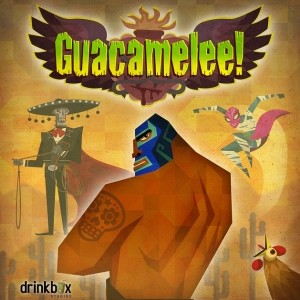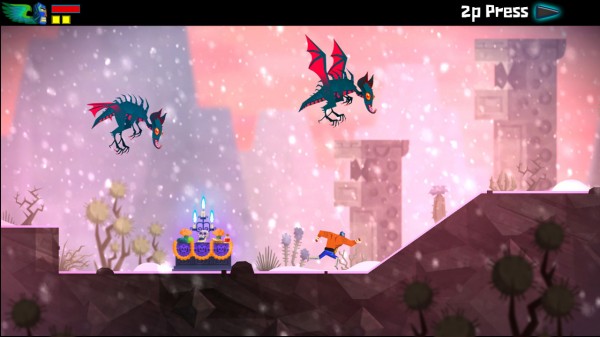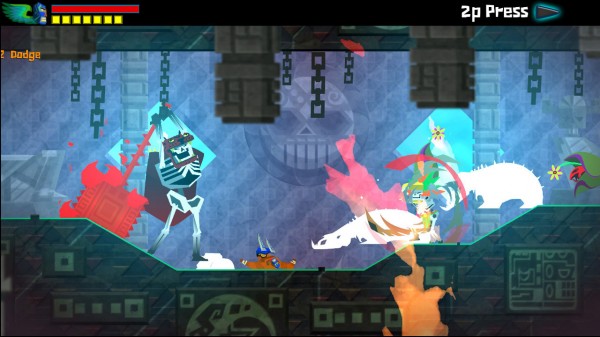Every Sunday, my brother and I like to boot up our SNES and throw on Tetris Attack. Most times, well, every time until recently, my brother stomped me. It’s like something would go off in his head any time I neared victory. Suddenly, I was facing Tom Cruise from that scene in “Minority Report” with all the screens and cool gloves and the technologies. Point is, my brother would stomp me. Until recently.
Likewise when I play my roommate in Street Fighter IV. We’re usually neck and neck (or he’ll stomp me in the face a lot). But recently his moves were predictable. What’s more, they were avoidable. My brother similarly so.
I’d like to credit this to a sudden savant-like epiphany, but really, it’s Guacamelee.
Drinkbox Studio’s newest adventure stirs something that has lain dormant until one of these types of games came around. It hones in on a reactionary study, as hard to obtain as it is to maintain after finishing with the game. Guacamelee is a 2D-Metroidvania-beat-’em-up-
Indie games have the ability, and thank God, to throw out ridiculous aesthetical choices without seeming unmarketable or odd. Choosing a lucha libre extravaganza — bright, animated, lovely — is Guacamelee’s chief-export and one reason for staying relevant in my life. So many other types of games that require backtracking and rediscovery lose me. Latter titles in the Castelvania series failed to hold my attention. I just couldn’t find another bat or another ghoul or another bat-ghoul worth the retread.
Here, in this vibrant mix of goat-men, rose dresses and Dia de los Muertos celebrations, I reveled. The environment’s painted atmosphere crossed Outland with “Emperor’s New Groove.” And the constant trickle of internetity always perked up my mood. Winking mentions of VVVVVV and the meme library help establish an identity for the game other than zany Mexican cultural exaggerations mixed with noisy anime delivery styling. It’s not depth, just a memorable nod.
But all of this is just a shell, a paint color choice on a specific type of car model. It’s what the car’s housing that really matters. Guacamelee streams together a dance of dodge/combo mechanics that are less abrasive and more inviting. It doesn’t judge fighting capabilities like others in its genre. Are there combo counts? Of course. No self-respecting brawler would go without one. It just pulls off the trick of making me forget there’s a reason to keep track.
There’s a notion in filmmaking I learned while listening to Kevin Conroy, as in the voice of Batman from the Arkham titles and the animated series. Conroy was criticizing Christian “Not Wearing Hockey Pads” Bale for his Batman voice-acting chops. Conroy explains that sometimes when actors and actresses are shown the footage of their daily shoots, they’ll start adjusting what was a natural performance to adhere to what they saw. Conroy called it “acting to the dailies.” The same can be said for how I treat combo counters.
In some games, DmC: Devil May Cry comes to mind, I’m too concerned with getting my combo rank to a SSS — SssUPER SSSWEET SSSssomething — to focus on all the enemies surrounding and pummeling Dante. But Juan Aguacate keeps my attention. Dodges, timing, and variety in combat are purer, in a sense. The 2D perspective distracts less and doesn’t hold my hand. There’s still a lot to take in at once during battle. Without planning, my life expectancy was nil. This planning and reactionary adaptability carried over into my other gaming experiences.
With nuance in presentation, the story ending up as it does is a major letdown. El Presidente’s Daughter, Juan’s childhood friend and distressed damsel, is kidnapped by the even less interesting Evil Charro Skeleton. While there are plays on the princess and the whole “other castle” thing, it’s left completely to Charro’s lackies to bring life to the circumstances. The daughter character blushes every time Juan’s near and Evil Charro pontificates some bologna about being evil and stuff.
The majority of weight-lifting is left to Flame Face and X’tabay, a gun-slinging drunk with a flame for a face and a bipolar witch-lady, respectively. Their characterization, as well as their character model movements, are electric. Unpredictable but fun. Their numerous taunt scenes — again, not very original — mix things up following an hour or so of room, platform, room, locked-off room, battle scene, room opens, continue. Evil Charro, meanwhile, could have spoke Spanish the entire game and not lost any of my interest.
Still, presentation outside of story is sometimes enough to bait me along. The world’s personality is accented with its rich combative nature. The movement of the game carries most of its eight hour expedition with ease. I never bemoaned going back and exploring older areas with newly bestowed power. The map system and color-coded power upgrades cleverly assisted my fading memory. It wasn’t daunting to find out what I missed.
And the art. THE ART. There’s a goofy passion infused with each area of the game’s world. And the segments that play around with the 2D perspective is like the creator’s just finding a reason to show everything off. It makes what’s usually a confined game feel like a hulking epic. Like it could reach further out from what’s shown room-to-room. Like there’s something it lends to anyone that plays it. At least it did for me. Because I stomped my brother.




















